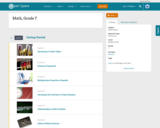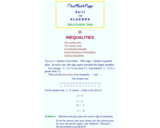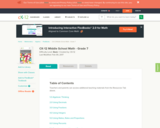
52 Results


Equations and Inequalities
Type of Unit: Concept
Prior Knowledge
Students should be able to:
Add, subtract, multiply, and divide with whole numbers, fractions, and decimals.
Use the symbols <, >, and =.
Evaluate expressions for specific values of their variables.
Identify when two expressions are equivalent.
Simplify expressions using the distributive property and by combining like terms.
Use ratio and rate reasoning to solve real-world problems.
Order rational numbers.
Represent rational numbers on a number line.
Lesson Flow
In the exploratory lesson, students use a balance scale to find a counterfeit coin that weighs less than the genuine coins. Then continuing with a balance scale, students write mathematical equations and inequalities, identify numbers that are, or are not, solutions to an equation or an inequality, and learn how to use the addition and multiplication properties of equality to solve equations. Students then learn how to use equations to solve word problems, including word problems that can be solved by writing a proportion. Finally, students connect inequalities and their graphs to real-world situations.
- Subject:
- Algebra
- Mathematics
- Provider:
- Pearson

Lesson OverviewUsing a balance scale, students decide whether a certain value of a variable makes a given equation or inequality true. Then students extend what they learned using the balance scale to substituting a given value for a variable into an equation or inequality to decide if that value makes the equation or inequality true or false.Key ConceptsStudents will extend what they know about substituting a value for a variable into an expression to evaluate that expression.Equations and inequalities may contain variables. These equations or inequalities are neither true nor false. When a value is substituted for a variable, the equation or inequality then becomes true or false. If the equation or inequality is true for that value of the variable, that value is considered a solution to the equation or inequality.Goals and Learning ObjectivesUnderstand what solving an equation or inequality means.Use substitution to determine whether a given number makes an equation or inequality true.
- Subject:
- Algebra
- Material Type:
- Lesson Plan
- Author:
- Chris Adcock
- Date Added:
- 02/28/2022

Lesson OverviewStudents use weights to represent equal and unequal situations on a balance scale and represent them symbolically.Key ConceptsAn equation is a statement that shows that two expressions are equivalent. An equal sign (=) is used between the two expressions to indicate that they are equivalent. You can think of the two expressions as being “balanced.”An inequality is a statement that shows that two expressions are unequal. The symbols for “greater than” (>) and “less than” (<) are used to indicate which expression has the greater or lesser value. In an inequality, you can think of the two expressions as being “unbalanced.”Goals and Learning ObjectivesExplore a balance scale as a model for equations and inequalities.Understand that an equation states that two expressions are equivalent using an equal sign (=).Understand that an inequality states that one expression is greater than (>) or is less than (<) another expression.Use the equal sign (=) and the greater than (>) and less than (<) symbols with rational numbers.
- Subject:
- Algebra
- Material Type:
- Lesson Plan
- Author:
- Chris Adcock
- Date Added:
- 02/28/2022

- Subject:
- Mathematics
- Material Type:
- Full Course
- Provider:
- Pearson
- Date Added:
- 02/28/2022

Algebraic Reasoning
Type of Unit: Concept
Prior Knowledge
Students should be able to:
Add, subtract, multiply, and divide rational numbers.
Evaluate expressions for a value of a variable.
Use the distributive property to generate equivalent expressions including combining like terms.
Understand solving an equation or inequality as a process of answering a question: which values from a specified set, if any, make the equation or inequality true?
Write and solve equations of the form x+p=q and px=q for cases in which p, q, and x are non-negative rational numbers.
Understand and graph solutions to inequalities x<c or x>c.
Use equations, tables, and graphs to represent the relationship between two variables.
Relate fractions, decimals, and percents.
Solve percent problems included those involving percent of increase or percent of decrease.
Lesson Flow
This unit covers all of the Common Core State Standards for Expressions and Equations in Grade 7. Students extend what they learned in Grade 6 about evaluating expressions and using properties to write equivalent expressions. They write, evaluate, and simplify expressions that now contain both positive and negative rational numbers. They write algebraic expressions for problem situations and discuss how different equivalent expressions can be used to represent different ways of solving the same problem. They make connections between various forms of rational numbers. Students apply what they learned in Grade 6 about solving equations such as x+2=6 or 3x=12 to solving equations such as 3x+6=12 and 3(x−2)=12. Students solve these equations using formal algebraic methods. The numbers in these equations can now be rational numbers. They use estimation and mental math to estimate solutions. They learn how solving linear inequalities differs from solving linear equations and then they solve and graph linear inequalities such as −3x+4<12. Students use inequalities to solve real-world problems, solving the problem first by arithmetic and then by writing and solving an inequality. They see that the solution of the algebraic inequality may differ from the solution to the problem.
- Subject:
- Algebra
- Mathematics
- Provider:
- Pearson

Students write and solve inequalities in order to solve two problems. One of the problems is a real-world problem that involves selling a house and paying the real estate agent a commission. The second problem involves the relationship of the lengths of the sides of a triangle.Key ConceptsIn this lesson, students again use algebraic inequalities to solve word problems, including real-world situations. Students represent a quantity with a variable, write an inequality to solve the problem, use the properties of inequality to solve the inequality, express the solution in words, and make sure that the solution makes sense.Students explore the relationships of the lengths of the sides of a triangle. They apply the knowledge that the sum of the lengths of any two sides of a triangle must be greater than the length of the third side to solve for the lengths of sides of a triangle using inequalities. They solve the inequality for the length of the third side.Goals and Learning ObjectivesUse an algebraic inequality to solve problems, including real-world problems.Use the properties of inequalities to solve an inequality.
- Subject:
- Algebra
- Geometry
- Material Type:
- Lesson Plan
- Author:
- Chris Adcock
- Date Added:
- 03/01/2022

Gallery OverviewAllow students who have a clear understanding of the content thus far in the unit to work on Gallery problems of their choosing. You can then use this time to provide additional help to students who need review of the unit's concepts or to assist students who may have fallen behind on work.Gallery DescriptionsMatch InequalitiesStudents match inequalities to their solutions.Product Between One-Half and OneStudents find a range of values for an inequality situation.Inequalities about NumbersStudents write inequalities to solve problems about the sums of three consecutive numbers.School DanceStudents use equations and an inequality to model the costs and revenues of holding a school dance.What Could My Number Be?Students use inequalities to identify possibilities for a number given certain conditions.Batting AverageStudents use an inequality to find the number of hits needed to get a desired batting average.
- Subject:
- Algebra
- Material Type:
- Lesson Plan
- Author:
- Chris Adcock
- Date Added:
- 03/01/2022

Students use inequalities to solve real-world problems. They see that the solution of the algebraic inequality may differ from the solution to the problem it represents. For example, a fractional number or a negative number may not be an appropriate solution for a word problem.Students complete a Self Check. They are given an algebraic inequality that they need to solve. They then write and solve a word problem that the inequality could represent.Key ConceptsIn this lesson, students write and solve an algebraic inequality that matches a situation given in a word problem. They then interpret that algebraic solution in the context of the problem. For example, students write and solve an algebraic inequality to represent the number of T-shirts that can be bought given a certain amount of money and another purchase. The inequality produces the solution t < 2.5. Since a fractional part of a T-shirt does not make sense, students reason that 2 is the greatest number of T-shirts that can be purchased.Goals and Learning ObjectivesInterpret the solution to an algebraic inequality within the context of a word problem.
- Subject:
- Algebra
- Material Type:
- Lesson Plan
- Author:
- Chris Adcock
- Date Added:
- 03/01/2022

Students work in pairs to critique and improve their work on the Self Check. Students complete a task similar to the Self Check with a partner.Key ConceptsTo critique and improve the task from the Self Check and to complete a similar task with a partner, students use what they know about solving inequalities, graphing their solutions, and relating the inequalities to a real-world situation.Goals and Learning ObjectivesSolve algebraic inequalities.Graph the solutions of inequalities using number lines.Write word problems that match algebraic inequalities.Interpret the solution of an inequality in terms of a word problem.
- Subject:
- Algebra
- Material Type:
- Lesson Plan
- Author:
- Chris Adcock
- Date Added:
- 03/01/2022

Students discover how the addition and multiplication properties of inequality differ from the addition and multiplication properties of equality.Students use the addition and multiplication properties of inequality to solve inequalities. They graph their solutions on the number line.Key ConceptsIn this lesson, students extend their knowledge of inequalities from Grade 6. In Grade 6, students learned that solving an inequality meant finding which values made the inequality true. Students used substitution to determine whether a given value made an inequality true. They also used a number line to graph the solutions of inequalities. By graphing these solutions on a number line, they saw that an inequality has an infinite number of solutions.Now, in Grade 7, students work with inequalities that also contain negative numbers and learn to solve and graph solutions for inequalities such as −2x − 4 < 5. This involves first understanding how the properties of inequality differ from the properties of equality. When multiplying (or dividing) both sides of an inequality by the same negative number, the relationship between the two sides of the inequality changes, so it is necessary to reverse the direction of the inequality sign in order for the inequality to remain true. Once students understand this, they can apply the same steps they used to solve equations to solve inequalities, but remembering to reverse the direction of the inequality sign when multiplying or dividing both sides of the inequality by a negative number.Goals and Learning ObjectivesAccess prior knowledge of how to solve an inequality.Observe that when multiplying or dividing both sides of an inequality by the same negative number, the inequality sign must change direction.Solve and graph inequalities of the form px + q > r or px + q < r, where p, q, and r are specific rational numbers.
- Subject:
- Algebra
- Material Type:
- Lesson Plan
- Author:
- Chris Adcock
- Date Added:
- 03/01/2022

Students solve a problem about a salesperson's compensation. They solve the problem first by arithmetic and then by writing and solving an inequality.Key ConceptsIn Lesson 11, students learned how to solve inequalities using the addition and multiplication properties of inequality. In this lesson, they solve word problems by writing and solving inequalities.To help students make connections and see how problems can be solved in different ways, students first solve the same problem using arithmetic.Goals and Learning ObjectivesWrite and solve an algebraic inequality to solve a word problem.
- Subject:
- Algebra
- Material Type:
- Lesson Plan
- Author:
- Chris Adcock
- Date Added:
- 03/01/2022

Here is a site that clearly and thoroughly explains many topics related to inequalities, including solving and graphing simple and compound inequalities. There are example problems solved, problems for the student to attempt, and answers to the student problems. Point this site out to students who have been absent or who need additional instruction on this or many other topics.
- Subject:
- Mathematics
- Material Type:
- Lesson Plan
- Provider:
- TheMathPage
- Author:
- Lawrence Spector, PhD
- Date Added:
- 12/01/2023

MathWorld provides a basic overview of Algebra. Includes a few formulas and many links to related topics.
- Subject:
- Mathematics
- Material Type:
- Lesson
- Provider:
- Wolfram
- Date Added:
- 12/01/2023

A work in progress, CK-12's Math 7 explores foundational math concepts that will prepare students for Algebra and more advanced subjects. Material includes decimals, fractions, exponents, integers, percents, inequalities, and some basic geometry.
- Subject:
- Algebra
- Functions
- Geometry
- Mathematics
- Material Type:
- Textbook
- Provider:
- CK-12 Foundation
- Provider Set:
- CK-12 FlexBook
- Author:
- Kershaw, Jen
- Date Added:
- 10/04/2010

In this lesson on evaluating expressions, students will learn how to evaluate expressions for given values using the order of operations.
- Subject:
- Mathematics
- Material Type:
- Interactive
- Lesson
- Provider:
- Nearpod
- Date Added:
- 08/07/2023

This math tutorial features notes and examples that illustrate how to solve inequalities that involve rational expressions.
- Subject:
- Mathematics
- Material Type:
- Reading
- Author:
- Paul Dawkins
- Date Added:
- 12/01/2023

Students learn how to solve equations and inequalities. Topics examined are linear equations, quadratic equations, linear inequalities, and absolute value inequalities. The class notes are available in pdf format.
- Subject:
- Mathematics
- Material Type:
- Lesson Plan
- Author:
- Paul Dawkins
- Date Added:
- 12/01/2023

To plot an inequality, such as x>3, on a number line, first draw a circle over the number (e.g., 3). Then if the sign includes equal to (≥ or ≤), fill in the circle. If the sign does not include equal to (> or <), leave the circle unfilled in. Finally, draw a line going from the circle in the direction of the numbers that make the inequality true.
Khan Academy learning modules include a Community space where users can ask questions and seek help from community members. Educators should consult with their Technology administrators to determine the use of Khan Academy learning modules in their classroom. Please review materials from external sites before sharing with students.
- Subject:
- Algebra
- Higher Education
- Mathematics
- Practitioner Support
- Material Type:
- Teaching/Learning Strategy
- Provider:
- Khan Academy
- Date Added:
- 11/17/2020

Gain an understanding of the different ways to solve equations by viewing examples and a video lesson. [2:21]
- Subject:
- Mathematics
- Material Type:
- Lesson
- Provider:
- Mathplanet
- Provider Set:
- Pre-Algebra
- Date Added:
- 10/01/2022